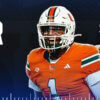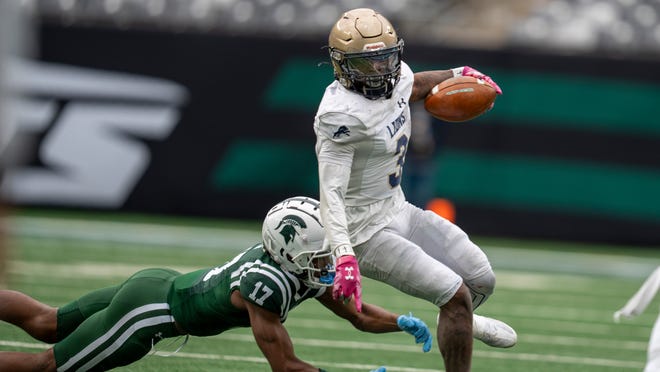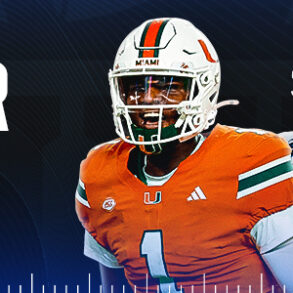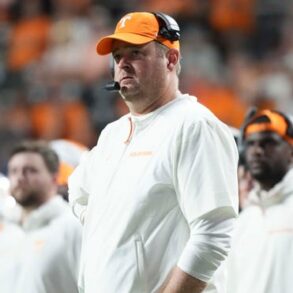You can track the prominent college football programs when they’re in North Jersey.
Assistant coaches or head coaches will either go south to north, starting at DePaul then moving up to Don Bosco and Paramus Catholic, or they’ll head down Route 17 from Don Bosco, making sure to hit Bergen Catholic down to DePaul.
Pretty soon on X, formerly known as Twitter, the football players at each school will post that they got an offer from that school. Sometimes they’re humbled, sometimes they’re honored and humbled.
But do those offers mean anything? Sort of. They all have meaning, but some more than others.
Right now, the world of college sports is evolving and no one knows quite how it’s going to end up. The impact is being felt daily in North Jersey.
Need a break? Play the USA TODAY Daily Crossword Puzzle.
Allowing athletes to profit from their own name, image and likeness was supposed to transform college sports by pumping money to athletes in exchange for their, you know, name, image and likeness, but has just become a way to hand kids cash for wearing a certain college uniform.
Soon, the NCAA will adopt a new revenue-sharing model that limits roster sizes (105 for football) for schools choosing to opt in. Scholarship limits are gone, so schools can offer full scholarships to any and all athletes on the roster. So that means more scholarships if schools choose to offer more, but fewer roster spots overall.
All of this means more questions. What happens to walk-on players? What happens to the transfer portal? Who gets money, who doesn’t? When is Signing Day for football? June? Now? Later? What happens if a college kid gets hurt? Is there a practice squad for college players? How does Title IX factor in?
And what does this all mean for high school sports?
“Nobody knows the answer,” St. Joseph football coach Augie Hoffmann said.
Are those offers real?
North Jersey boasts some of the best high school football in the nation, sending athletes to colleges coast to coast. Remember, reigning national champion Ohio State had a roster with a star from St. Peter’s Prep (Cody Simon) and Union (Davison Igbinosun).
It’s not unusual for a North Jersey school to see multiple big-time programs come in on a given day for a visit, chat, maybe a look at some film. Bill Belichick visited North Jersey just days after getting the job at North Carolina.
Every school comes with offers. But any good sports fan should wonder, are these offers real?
I mean, if every North Jersey kid accepted an offer from North Carolina, there would be at least seven of them on the Tar Heels. What would North Carolina do with the rest of the country? Those offers can’t possibly all be real.
Paramus Catholic football coach Greg Russo said it’s different now than it was, it depends on the grade of the kid getting the offer and there’s a lot of ‘nuance.’
“The offer means I will recruit this guy,” Russo said. “When you’re young, like my freshmen and sophomores, if they get an offer, it means they’re going to recruit you.”
Understanding an offer
There are multiple ways to look at an offer. The biggest question asked is whether or not it is a ‘committable offer’, meaning that if the player accepts, the school will honor it.
Usually the answer is no. But the schools, the kid and social media all play along.
For the college programs, it’s marketing. ‘Hey, look at us, we are offering the best players in North Jersey’. Programs have been known to actively prod a player to make sure they post the news of the offer on social media. They want the likes on Instagram too.
For the high school, well, it makes them look good. Hey, Bill Belichick was here. It makes the players look good too.
Is it real? Well, sort of. It’s really more like asking a kid, ‘why don’t we hang out sometime and get to know each other better?’
“The biggest answer comes Aug. 1, when the official letters come out, how many kids get the official scholarship letters,” Hoffmann said. “A lot of kids find out the hard way.”
When the offer really becomes real
The college offer has become like a cryptocurrency. It may rise in value over time, or it may just be a piece of paper with some words on it.
“Social media is a reality to these people,” Russo said.
Offers usually come with an invitation for a player to come visit campus for a camp or a tour, but these are on the kid’s own dime, which mean the college still hasn’t spent any actual resources.
The best way to tell whether or not an offer is real is whether it comes with an official visit, because that’s when the colleges pay for things.
The transfer portal (you knew we’d get to that) has changed the tone of a college offer as well. Colleges are offering more kids, casting a wider net, because they don’t always know what they have coming in and out on a regular basis because the portal never sleeps.
They may think they have a QB, but then they don’t. And then they either have to replace the player they just lost with a high school prospect or another kid in the portal.
Also, if they offer a player in North Jersey and that player commits somewhere else, it’s possible the player may enter the portal after a year or two. If that happens, that first college can say they made an offer back when he was in high school.
North Jersey coaches made the point that Rutgers is actually at a disadvantage when it comes to offers here, because they don’t want to make blanket offers to a bunch of kids they aren’t super interested in because they don’t want to alienate the coaches down the line.
If Rutgers really wants a North Jersey kid, the Scarlet Knights tend to wait. That can have drawbacks as well, though, because kids all want to be ‘shown love’ early. And since everything is in flux, high school coaches tell kids about every offer and every school, because they just don’t know what might happen.
Changing the numbers
There are a handful of prominent North Jersey football players from last season, including Paramus Catholic quarterback Crew Colon, who have made the big decision to reclassify to the 2026 graduating class. Their eligibility in New Jersey is up, but they can do a postgrad year at a prep school.
Athletes choose this route for many reasons: To improve academically, to enhance their talents and skill on the field, but now it might be done just because there’s nowhere for a good player to go.
“Everyone thought that the COVID rule was out of the way and now, but because of the portal and the JUCO’s not counting (against college eligibility), all of these guys are still eligible,” Russo said with a laugh.
The cream of the North Jersey 2025 crop, Malachi Goodman (Penn State), Nolan James Jr. (Notre Dame) and Quincy Porter (Ohio State), took part in the standard recruiting process. Granted, it’s accelerated − kids used to commit after the high school season, now it’s usually before − but still the same as it was 20 years ago.
Schools come in, make legitimate offers, the kid makes visits, gives interviews saying it felt like ‘home’ and picks a school.
But the kids in the next level, call them the one- and two-star kids, are struggling. Reclassifying is one way to buy time. A kid may not fit in a school’s recruiting class this year, but maybe he does in 2026.
Russo said he worries about the FCS schools or smaller FBS schools and how they will compete during the revenue sharing age that is around the corner. North Jersey football coaches are trying to balance the changing rules on college recruiting with building their own programs and keeping everyone happy.
“It’s hard on everyone,” Russo said. “You’re chasing a moving target and you don’t even know what you’re chasing.”
This post was originally published on this site be sure to check out more of their content.










